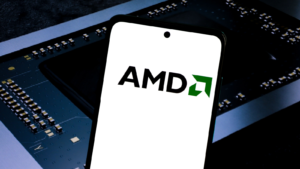In the space of tech and commerce, certain industry titans emerge as the architects of leading innovations. Three companies stand at the forefront, each pioneering groundbreaking advancements in their respective domains. The first one’s prowess in semiconductor technology, the second one’s strides in AI hardware, and the third one’s e-commerce juggernaut status reveal a glimpse into the future. These are the revolutionary stocks you need to add to your portfolio.
The first one’s strategic focus on deep ultraviolet (DUV) and extreme ultraviolet (EUV) technologies suggests its commitment to staying ahead in chip manufacturing. Meanwhile, the second one’s foray into AI hardware and strategic acquisitions cements its role in shaping the future of AI. On the e-commerce front, the third one’s stellar performance, marked by a significant revenue surge, demonstrates its ability to navigate consumer dynamics and leverage cutting-edge technology for international growth.
Read the article to explore the trajectories of these three industry giants. Learn how revolutionary stocks are predicted to dominate the tech landscape by 2026.
ASML (ASML)

To begin with, ASML’s (NASDAQ:ASML) focus on the growth of DUV revenue towards 55% year-over-year (Q3 2023) suggests the ongoing relevance of this technology. The expectation of around 25% year-over-year revenue growth for EUV in 2023 reflects the significance of advanced lithography technologies. Hence, ASML’s focus on advancing and commercializing EUV technology remains its competitive edge.
Furthermore, the ongoing preparations for high numerical aperture (High-NA) technology and capacity building to capture the demand in 2025 highlight ASML’s move to stay at the edge of chips’ technological advancements. High-NA technology is a critical innovation in semiconductor lithography, enabling the production of smaller and more densely packed chips.
Despite uncertainties in the market, ASML’s operational performance in Q3 signifies its efficiency in managing product mix, controlling costs, and delivering on sales logs. The outperformance in gross margin and the alignment of operating expenses with guidance reflect a well-executed operational strategy.
Additionally, the order book, a forward-looking indicator, revealed Q3 net system bookings of €2.6 billion, which comprised €0.5 billion for EUV bookings and €2.1 billion for non-EUV bookings. Net system bookings were predominantly driven by logic, accounting for 80%, while memory constituted 20%. Hence, this sizable backlog provides revenue visibility and reflects the potency of ASML’s topline.
Finally, breaking down the net system sales, logic accounted for a majority (76%), with memory contributing 24%. This highlights ASML’s market diversification and reveals the sectors driving the company’s sales. Therefore, understanding sales distribution across different segments is essential for gauging ASML’s market penetration and revenue streams.
AMD (AMD)

Momentum in AI hardware is now becoming the fundamental core of AMD (NASDAQ:AMD). The progress includes the development of the next-generation Instinct MI300 accelerators, with production shipments supporting the El Capitan Exascale supercomputer. There is an integration of AMD’s ROCm software into mainstream AI ecosystems, such as PyTorch and TensorFlow. This demonstrates the company’s edge in creating a hardware-agnostic software environment.
Additionally, AMD’s focus on enhancing AI capabilities can be observed in strategic acquisitions. Notable additions to its AI software capabilities include Mipsology and Nod.ai. Mipsology’s expertise in delivering AI software for data centers, edge, and embedded markets complements AMD’s adaptive System-on-Chips (SoCs). On the other hand, Nod.ai brings a team with substantial contributions to open-source AI compilers, reinforcing AMD’s software portfolio used by major cloud enterprises.
Furthermore, the collaboration with AI start-up Lemon.ai reflects AMD’s focus on fostering partnerships. The achievement of software parity with CUDA for Lemon.ai’s LLMs running on Instinct MI250 GPUs highlights AMD’s capability to facilitate the deployment of production-ready AI models with minimal code changes, expanding the applicability of its hardware solutions.
As a result, in Q3 2023, AMD’s topline had a year-over-year increase of 4% and a sequential growth of 8%. Meanwhile, the gross margin stood at 51%, stable year-over-year. Moving down, operating expenses increased by 12% year-over-year, primarily driven by higher research and development (R&D) investment to support AI growth opportunities.
Finally, on the product side, building on the momentum of the EPYC CPU portfolio, AMD is set to introduce next-generation Turin server processors based on the new Zen 5 core. Customer feedback on Turin has been positive, with a planned launch in 2024. Hence, these developments support AMD’s market dominance in the coming year.
PDD (PDD)

PDD’s (NASDAQ:PDD) Q3 performance, showcasing a remarkable 94% year-over-year (Q3 2023) revenue increase, indicates the platform’s robust growth trajectory. This substantial growth aligns with the recovering consumer sentiment and reflects PDD’s effectiveness in capturing the resilience of the consumption market. The company’s ability to outpace the industry average growth rate demonstrates its competitive strength and adept market positioning.
PDD’s focus on balancing quality and price aligns with contemporary consumer behavior. The focus on providing more savings and better services positions PDD as a consumer-focused platform. Investments in platform resources to enhance the selection of quality products at affordable prices reinforce the company’s dedication to meeting consumer expectations.
Furthermore, PDD strategically utilized special promotions and shopping festivals, such as the Duoduo Harvest Festival and the National Brand Festival, highlighting the platform’s ability to adapt to market dynamics. By offering consumers attractive prices during these campaigns, PDD stimulates demand and cultivates a positive association between the platform and its user base.
At its core, PDD’s substantial investment in research and development, reaching RMB2.8 billion in Q3, attests to its lead in industry advancements. This investment may foster sustainable growth and ensure a competitive edge in the rapidly evolving e-commerce landscape.
Finally, PDD’s lead into international development within just a year reflects its agility and adaptability. By leveraging its established supply chain capabilities, PDD facilitates direct engagement between manufacturers and consumers in more than 40 countries. Therefore, PDD’s focus on creating a next-generation supply chain and shopping experience positions it as a leading player to capitalize on e-commerce growth.
As of this writing, Yiannis Zourmpanos held a long position in ASML. The opinions expressed in this article are those of the writer, subject to the InvestorPlace.com Publishing Guidelines.
